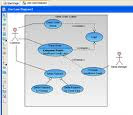Use Case Diagram
 Well..these days, Object oriented Analysis and Design is more famous than Analysis Structure. we used to be really appreciate and enjoy using tools such as Data Flow diagram, (DFD), Data dictionary and others, the researcher who found them, really give us good science in "Computer Science". Talking about Use case Diagram we can think like using DFD in Analysis Structure, we use Use Case Diagram to know about System when we see from outside system (external world) and what should it have from the system.
Well..these days, Object oriented Analysis and Design is more famous than Analysis Structure. we used to be really appreciate and enjoy using tools such as Data Flow diagram, (DFD), Data dictionary and others, the researcher who found them, really give us good science in "Computer Science". Talking about Use case Diagram we can think like using DFD in Analysis Structure, we use Use Case Diagram to know about System when we see from outside system (external world) and what should it have from the system.Use case diagram have at least three components such as actor, use case it self and association. Actor it can be a person or machine or device, let's say for Actor in the ATM system is at least Operator, Customer and Bank. Use case is the component key of the system, without Use Case, the system can not be run, for example Use Case Diagram for Simple ATM system is Use Case Turn On, when the machine turns on for the first time, so the ATM machine can connect to Database Server of the Bank, and the second one is Use Case Turn Off, in this Use Case, the Operator can fill in the Machine of ATM with some money if there is empty or for making maintenance or others.
another Use Case of Simple ATM Use Case is Transaction with can be inherit Use Case Withdraw and Use Case Transfer and Other Transaction. Association is a link which relate from Actor to Use Case, OK, perhaps we can practice it by drawing in a tools of UML such as Rational Rose or for Open Source UML tool we can use JUDE Comunity, you can download it for Free, just googling, Gee... it's not difficult if have a big will to learn or study, Cheer ! (Ader, 'Informatics of ITB"

